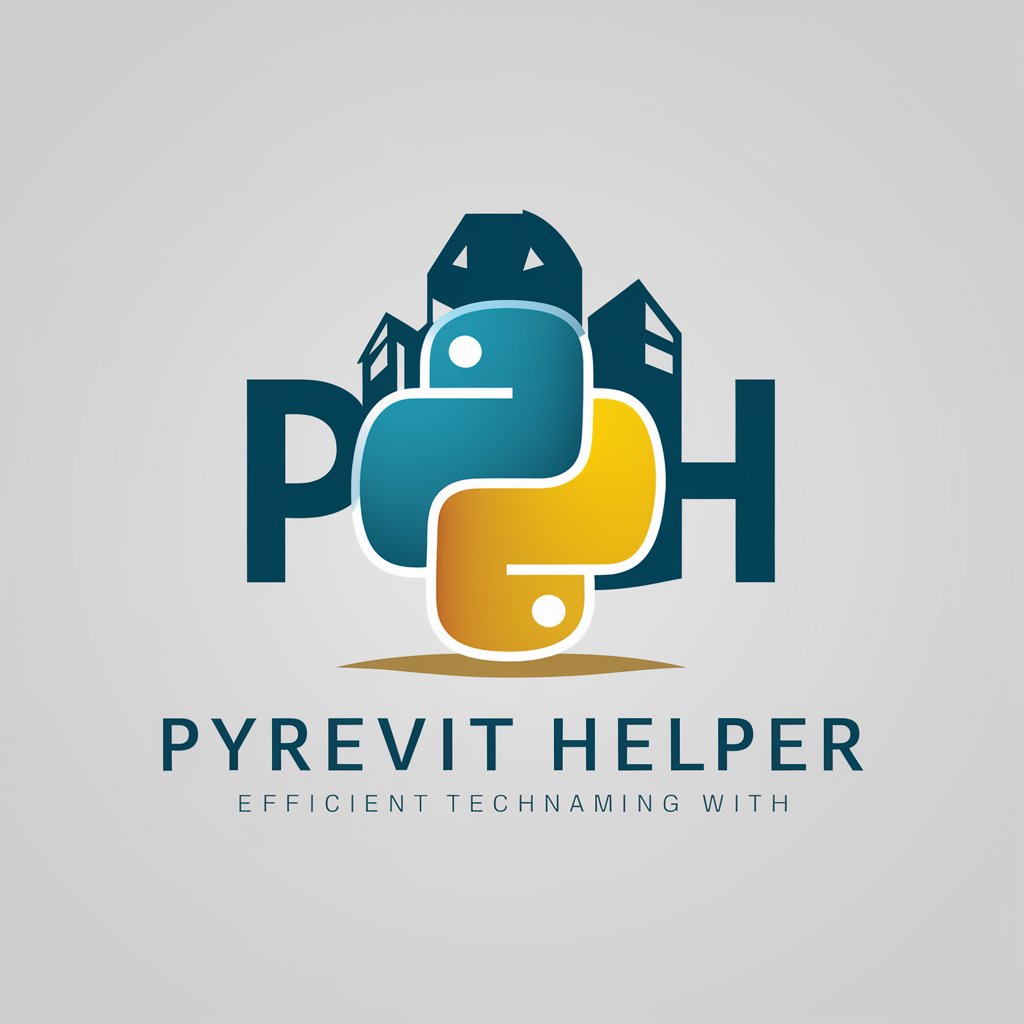PyRevit Helper - Revit API Scripting Tool

Hello! How can I assist with your PyRevit project today?
Enhancing Revit with AI-driven scripting
Create a logo that...
Design an emblem for...
Generate a modern logo for...
Craft a visual identity for...
Get Embed Code
Introduction to PyRevit Helper
PyRevit Helper is a specialized tool designed to assist users with Python scripting for PyRevit, an extension framework for Autodesk Revit, which is widely used in the architecture, engineering, and construction industries. The primary role of PyRevit Helper is to provide accurate and efficient Python code solutions that interact with the Revit API, enabling users to automate tasks, manipulate Revit elements, and enhance productivity within the Revit environment. PyRevit Helper ensures that all code suggestions are compatible with the specified Revit version by referencing the official Revit API documentation and structuring code in a way that adheres to PyRevit conventions. Powered by ChatGPT-4o。

Main Functions of PyRevit Helper
Generate and Modify Revit Elements
Example
Creating walls, modifying their properties, or adjusting their location.
Scenario
An architect needs to quickly prototype different wall configurations in a Revit model. PyRevit Helper provides a script to generate walls based on specified parameters, such as length, height, and material, making it easier to visualize and modify designs within Revit.
Automation of Documentation
Example
Automating the creation of sheets, views, and annotations within Revit.
Scenario
A BIM manager requires the automatic generation of multiple sheets for a project, including assigning views and annotations. PyRevit Helper provides scripts that can automate these tasks, significantly reducing manual effort and ensuring consistency across project documentation.
Data Extraction and Reporting
Example
Extracting detailed information from a Revit model for reporting purposes.
Scenario
A structural engineer needs to generate a report detailing the specifications and quantities of materials used in the model. PyRevit Helper can produce scripts to extract this data, format it, and prepare it for export to various formats like Excel or PDF.
Ideal Users of PyRevit Helper
Architects and Engineers
These professionals benefit from PyRevit Helper by streamlining repetitive tasks, automating documentation, and modifying design elements swiftly in their Revit models. This allows more time for design and less time on routine tasks.
BIM Managers
BIM Managers utilize PyRevit Helper to enforce standards, manage project workflows, and automate tasks that require consistency across large teams and projects. This tool helps in managing complex projects with efficiency.
Software Developers in AEC Industry
Developers working in the architecture, engineering, and construction sectors can use PyRevit Helper to write and test custom scripts tailored to specific project needs, enhancing the functionality of Revit through customized automation and integration with other tools.

How to Use PyRevit Helper
1
Visit yeschat.ai for a free trial without login, also no need for ChatGPT Plus.
2
Install the pyRevit tool on your system which is a prerequisite for using PyRevit Helper. Ensure that Autodesk Revit is already installed as PyRevit relies on it.
3
Load PyRevit Helper by attaching it as a script library in pyRevit. This can be done from the pyRevit tab in the Revit ribbon.
4
Use the PyRevit command line to run specific scripts or use the interactive menu to access common tasks such as managing Revit elements or automating repetitive processes.
5
Explore additional resources and documentation on the PyRevit GitHub page to better understand script functionalities and to customize scripts according to your needs.
Try other advanced and practical GPTs
Eve
Empowering decisions with AI

Hebrew Helper
Bridging Languages with AI

Linguist Lens
Enhance Your Writing with AI

PromptTurbo
Empowering Your AI Interactions

Ruby Dou
Streamline Your Ruby Development with AI

Image Text Extractor
Power Your Text Extraction with AI

Docs
Craft Documents Smartly with AI

Super Video Explainer
Unlock Video Insights with AI

Expert Assistant
Empowering Inquiry with AI Expertise

Heroínas y Príncipes
Transform Photos into Fantasy Characters

Magic The Making
AI-powered assistance for MTG enthusiasts.

SOC2 Copilot
AI-powered SOC2 compliance made easy

Frequently Asked Questions about PyRevit Helper
What is PyRevit Helper and how does it integrate with Revit?
PyRevit Helper is a script library designed for use with pyRevit, a tool that extends the functionality of Autodesk Revit through custom scripts and tools. It integrates by utilizing the Revit API to allow users to automate tasks, manage data, and enhance productivity within the Revit environment.
Can PyRevit Helper work with different versions of Revit?
Yes, PyRevit Helper is designed to be compatible with multiple versions of Revit. It's crucial to specify the version of Revit in use so that the helper can provide accurate code and API usage that's compatible with that particular version.
How do I troubleshoot errors when using PyRevit Helper?
Common troubleshooting steps include checking the script for syntax errors, ensuring compatibility with the Revit version, and consulting the pyRevit documentation. Additionally, users can participate in forums and communities for more specific solutions.
What are some common use cases for PyRevit Helper?
Common use cases include automating repetitive tasks, generating documentation, customizing user interfaces within Revit, and managing large sets of model data more efficiently.
Is programming knowledge required to use PyRevit Helper?
Basic programming knowledge, especially in Python, is beneficial when using PyRevit Helper as it involves scripting. However, many scripts can be used with minimal coding knowledge due to pyRevit's user-friendly interface and community resources.
